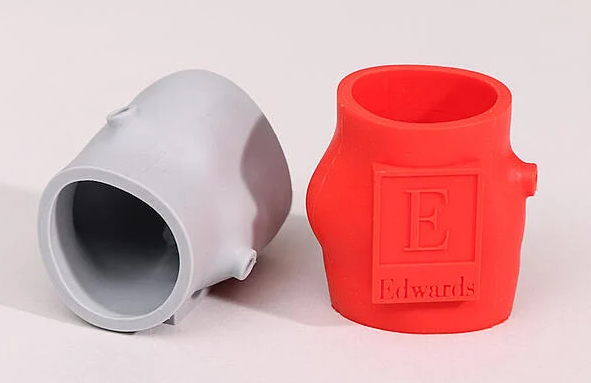
Precision, consistency, and quality are essential in manufacturing medical components. That’s why injection molding has gained popularity among medical OEMs–it meets these demands while offering numerous advantages. It’s also why so many medical companies choose to partner with us for their injection molding needs.
In this post, we’ll explore why injection molding is the ideal choice for medical components, covering key benefits such as flexibility, speed, cost-effectiveness, and shorter production times.
Quality of Production
In the medical device industry, there’s no room for error. Injection molding ensures high-quality, consistent parts in large volumes with tight tolerances—critical for surgical instruments, diagnostic tools, and drug delivery systems.
When considering silicone for medical devices and components, injection molding offers a closed material delivery system, which helps prevent contamination and ensures a clean product. This process is often carried out in white room or cleanroom environments, where strict cleanliness standards are maintained. In contrast, overseas silicone production often relies on compression molding, which isn’t as clean or controlled.
It also enables mass production of disposable medical items, reducing sterilization requirements and risk. For components that must be durable and reusable, silicone injection molding offers a sterile production method. Antimicrobial agents can even be incorporated into the resin during production, resulting in microbe-resistant surfaces.
Improved Form & Function
Silicone injection molded products offer limitless design possibilities, combining both aesthetics and functionality. Manufacturers can create highly complex geometric shapes and vibrant, uniquely colored products.
Injection molding, paired with the correct pigments, enables color-coded medical components for easier use by patients and professionals. Unlike other materials, the color in injection molded medical products is embedded within the material itself, ensuring it won't fade over time.
Beyond color, injection molded plastics and silicones are versatile and can be tailored to meet specific environmental requirements—something that may not always be possible with other materials. Whether your components need to withstand the conditions inside MRI machines or endure daily handling by patients, injection molding allows for customization to ensure durability and longevity, provided you work with a manufacturer who can guide you in selecting the right resin mix.
Faster Production and Shorter Lead Times
Speed is a crucial factor in medical manufacturing, where demand for high-quality components can fluctuate rapidly. Injection molding significantly reduces production time compared to other manufacturing methods like CNC machining or additive manufacturing. Once the mold is created, large volumes of components can be produced in a short period, making it an excellent option for time-sensitive medical applications.
Flexibility & Efficiency
If you're introducing a new product or modifying an existing one, partnering with the right medical component injection molder is key for a successful manufacturing process. Injection molding is a highly precise process that requires deep expertise in chemical interactions and physical properties.
A skilled injection molder can review and advise on your CAD files before production begins, ensuring your design is refined to meet your product’s exact requirements. This collaboration makes the process more flexible and efficient.
Working with the right molder also ensures that even complex components—like lightweight parts with integrated hinges, joints, and handles—are produced in a single step. This not only streamlines production but eliminates the need for costly multi-step assembly, further enhancing the efficiency and value of your manufacturing process.
Cost-Effectiveness of Injection Molding for Medical Components
Cost efficiency is a critical consideration in medical manufacturing and injection molding provides significant savings over the long term. While the initial mold creation requires an investment, the per-unit cost decreases substantially with high production volumes. This makes it an ideal solution for medical components that require large-scale manufacturing.
Additionally, injection molding minimizes material waste by using precision molds that optimize raw material usage. The efficiency of the process reduces labor costs and the need for post-processing, further enhancing cost-effectiveness.
Traceability of Supply Chain
It’s not uncommon for medical devices to require overmolding to provide grip, create seals or add a level of functionality. And it is essential that these extra parts are just as high-quality. Sub-assembly of more complex medical devices can be troublesome when it comes to working with lots of different vendors.
At Extreme Molding, we ensure that all sourced items for assembly are fully traceable and made in the US. Since we handle both plastic and silicone molding internally, we streamline the process to keep production under one roof, reducing the need for multiple manufacturers. This not only saves you time but also gives you peace of mind, knowing that every part manufactured through our injection molding process meets the highest quality standards at every stage.
Scalability for Large-Scale Production
Injection molding allows for seamless scalability, ensuring that whether you need a small batch for testing or a large run for full-scale distribution, production can be adjusted accordingly. With the ability to produce thousands—or even millions—of components with consistent quality, injection molding is an ideal choice for companies looking to scale their operations efficiently.
Working With Us
At Extreme Molding we are:
- ISO 9001:2015 and ISO 13485:2016 certified
- QRS and FDA-compliant, including process validations for medical components
- Highly experienced in the medical components field, our team having been manufacturing in this sector for over 50 years